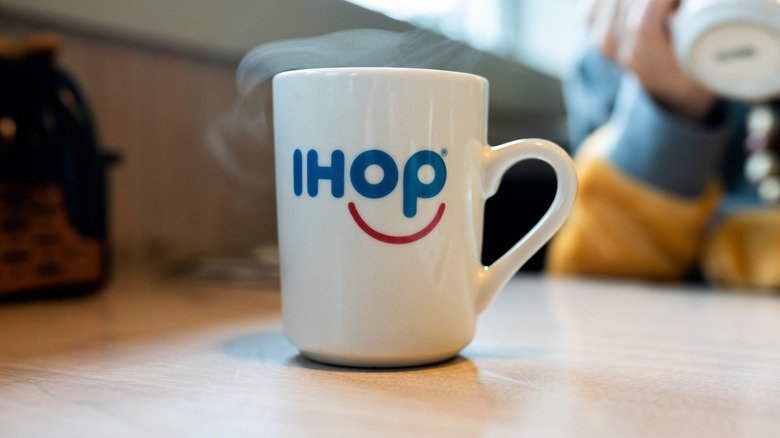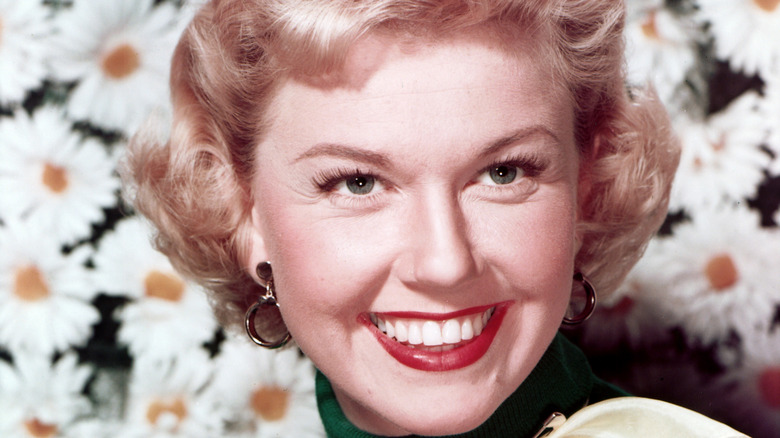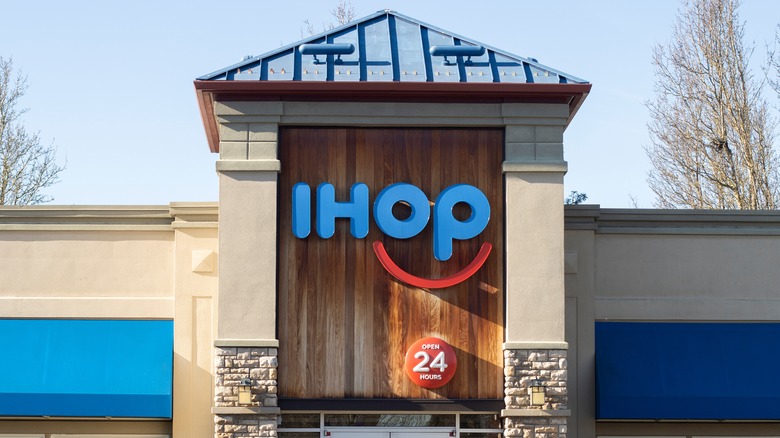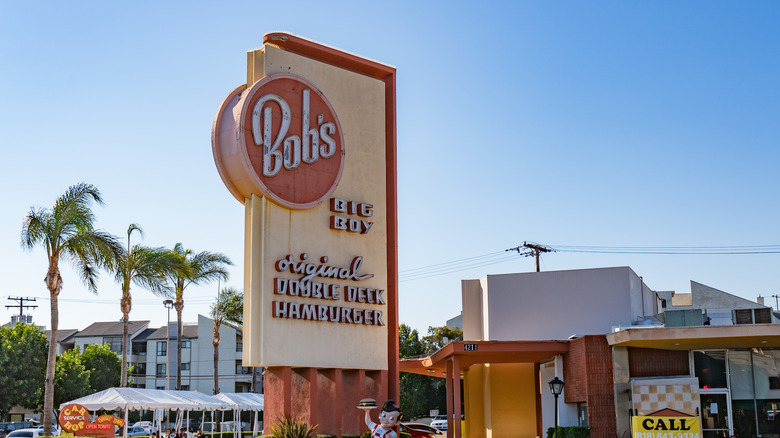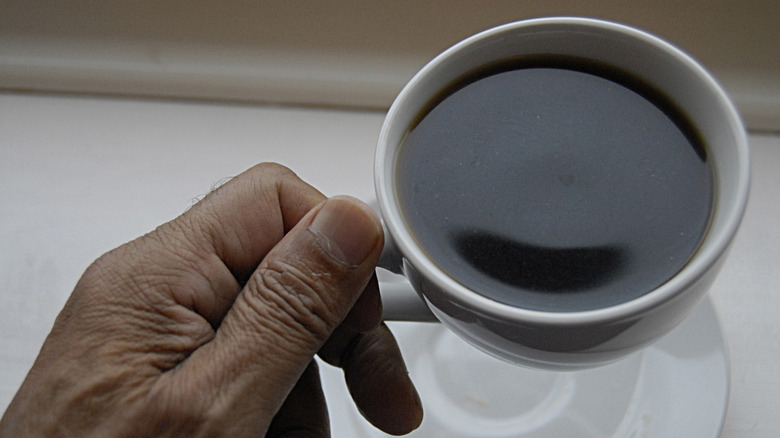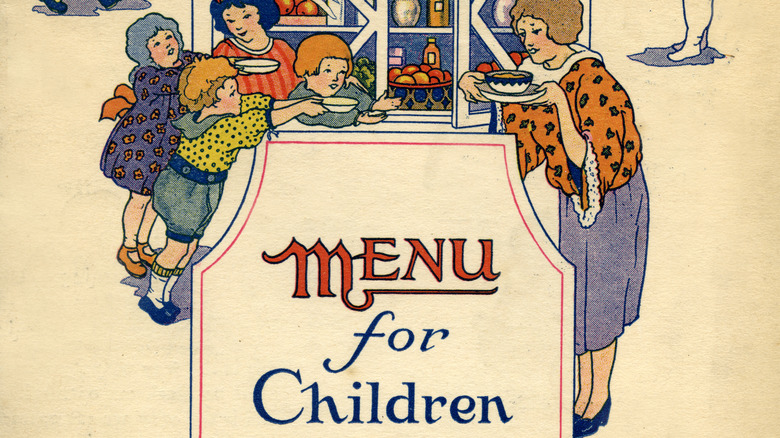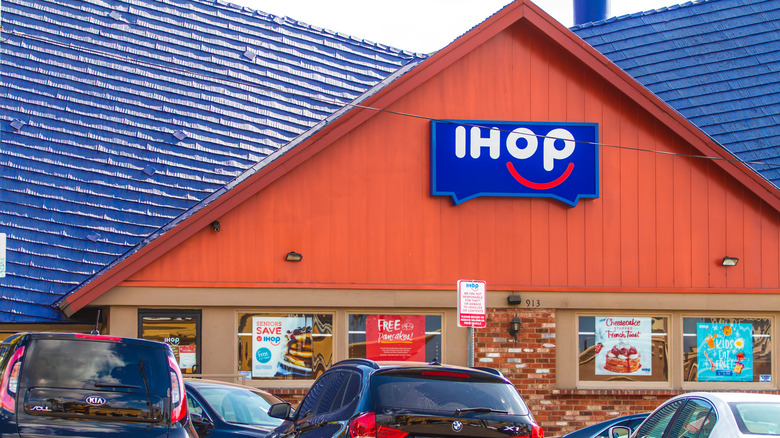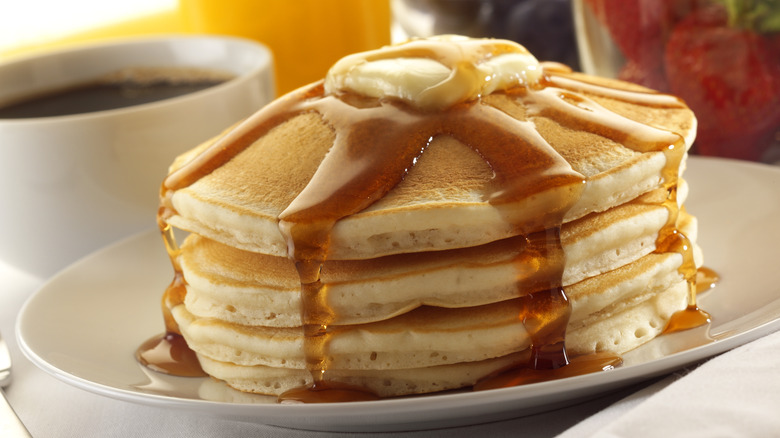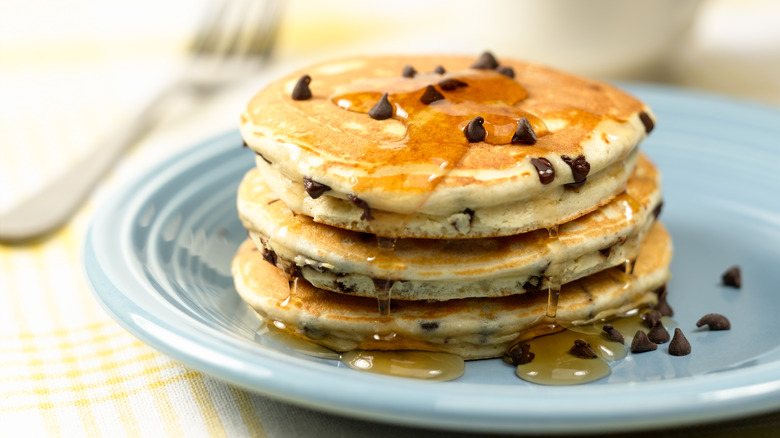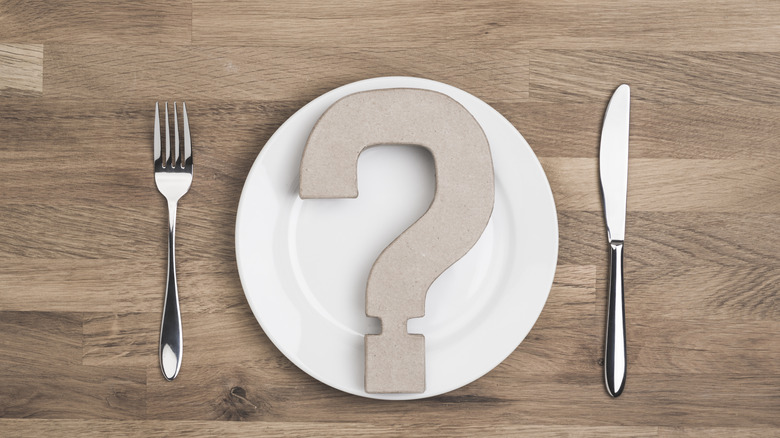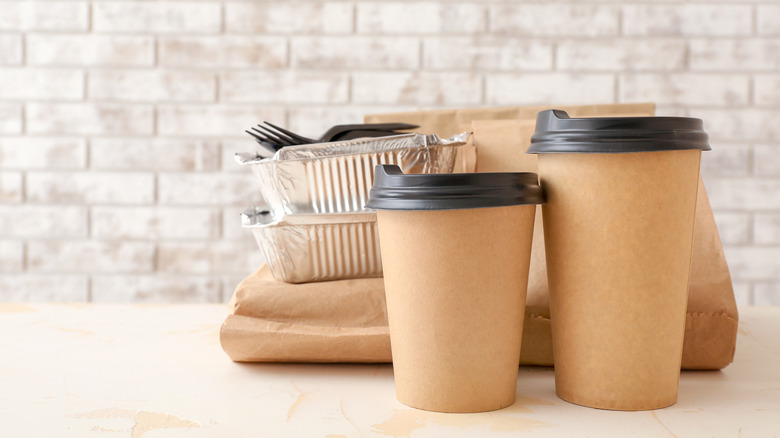What It Was Really Like To Eat At The First IHOP
The International House of Pancakes (also known as IHOP) got its start in 1958. That's when one of its co-founders decided pancakes and waffles would be the right combination of foods to attract customers to a new business. Pancake restaurants had already been around for a long time, and the soft, buttery, carby discs were easy and cheap to make. This factor turned them into a favorite food during the Great Depression of the 1930s. But their appeal was already huge long before then and only increased as the 20th century progressed. By the 1950s and 1960s, the pancake restaurant had become a popular destination for families trying to find foods that both adults and children could agree on.
But, compared to other breakfast spots, IHOP proved to be next-level. Not only did the restaurant serve very tasty pancakes, but it also offered unique menu items that had never been used anywhere else. The affordable prices, extensive menu, great location, and intriguing recipes mixed with more traditional fare drew people in immediately.
It's safe to say that the company has changed a lot over the years. Anyone eating at the very first IHOP location would have had an experience that was rather different from what customers can expect today. Here's what it was like to eat at the very first IHOP back in 1958.
You might have seen celebrities at neighboring tables
If you had gone to the first IHOP, there was a good chance that at some point a well-known Hollywood star or musician would have been eating pancakes there at the same time. That's because IHOP's first restaurant was in Toluca Lake, between the cities of Los Angeles and Burbank. The city of Burbank was (and still is) home to major movie studios like Warner Brothers. Hat proximity to the studios plus a quiet residential environment attracted plenty of celebrities to the neighborhood. Bette Davis, Bob Hope, and Debbie Reynolds all used to live in Toluca Lake, and the neighborhood remains a favorite of current-day celebrities.
It wasn't a surprise, then, that celebrities would grab a bite to eat at nearby restaurants, whether they lived in the area or were working at one of the studios. The International House of Pancakes quickly became a favorite of many celebrities, with screen legends like Doris Day and Jimmy Stewart regularly stopping in for meals. As neat as that must have been for fans, the fact that the celebrities kept coming back implies that everyone was pretty good about letting those big-name stars eat in peace.
You wouldn't have called it IHOP
Picture it: the year is 1958 and you're asking your family where they want to go for breakfast over the weekend. Would you ask them if they wanted to go to their favorite IHOP again? No, because until 1973, "IHOP" just wasn't a thing.
Business names, especially those that form memorable acronyms, usually end up with a short form partly because repeating very long names gets tiresome. Surely we can all agree that "International House of Pancakes" is quite a mouthful to say (pun fully intended). Also, those long names take up significant amounts of real estate atop business letterhead, on signs, and in any other form of printed advertising. They also take more time to say in radio and television ads, which can increase the price of securing those spots.
So, in 1973, the company's marketing department created a new acronym that could save money on signs and advertising. Since then, IHOP has become the company's default name, even though the longer version is still technically in use.
You might have been poached from Bob's Big Boy
If you grew up between the 1940s and 1980s in the U.S., chances are good that you've at least heard of Bob's Big Boy restaurants. While the chain shrank substantially in the 1990s and 2000s, it still has a few locations open in Southern California, including one in Toluca Lake that opened in 1949. This location happens to be right across the street from the very first IHOP.
That wasn't exactly a coincidence. IHOP's founders had seen long lines at Bob's Big Boy and thought that maybe they could attract some hungry diners who didn't want to wait. While IHOP's publicity focused on pancakes, the restaurant did serve burgers even way back in 1958. So, if the wait at Bob's was too long, you could easily cross the street and get a burger at IHOP, or maybe try one of the many pancake varieties on the menu. Just how many people left the line at that particular Bob's Big Boy is unknown, but we do know that the new pancake restaurant became popular very quickly. That Bob's location apparently didn't suffer that much as the IHOP is long gone, but that Bob's Big Boy restaurant is still very popular.
You would have had your own coffee pot at your table
If you've ever thought that all of your jokes about urgently needing coffee had a grain of truth in them, IHOP co-founder Al Lapin, Jr., would have happily agreed. Lapin, who died in 2004, used to work in government film production. The films he produced covered atomic attacks and survival, and as part of his work, Lapin learned a lot about how to distribute mass quantities of food to large numbers of people. While this knowledge had more to do with how the government would distribute supplies in a national emergency, Lapin translated that into a wholesale coffee company that served other businesses.
When he saw how well other fast food companies were doing, Lapin decided that he really wanted his own restaurant. He eventually opened the International House of Pancakes with his brother. One particular part of his experience with the coffee business heavily influenced IHOP: Each table got its own coffee pot so diners didn't have to ask waitstaff for a refill every time. That eliminated many delays when it came to getting coffee to customers.
Your kids wouldn't have had their own menu section
Today, IHOP regularly offers its "Kids Eat Free" promotions and also boasts a sizable kids' menu. But if you went back in time to visit their first location, you wouldn't have found either one available. Serving children separate foods just wasn't on the company's radar, even though children's menus had been around for decades.
Before the 1920s in the U.S., families didn't take their kids out to eat a lot. It was expensive, many places wouldn't allow kids in the first place, and those kids who did get to eat out simply ate whatever their parents ordered. But Prohibition made restaurants look for additional income to make up for the loss of booze-related money. For many places, creating a child-only menu seemed like one way to do just that.
The idea was a hit, although the fare offered to little ones tended to be very plain compared to what adult menus had on offer. Yet IHOP didn't jump on the child menu bandwagon until the 1980s. What's more, it didn't start offering free kids' meals each night until 2009, when it wanted to entice families who weren't eating out due to the economic recession. Today, IHOP's kids' menu is for those aged 12 and younger, and most of the dishes stay under 600 calories.
Your menu would have followed a theme
The International House of Pancakes didn't get its name from having a bunch of sister locations around the world. In fact, the chain didn't open any restaurants outside the U.S. until 1969, when it debuted a location in Canada. Actual international expansion was relatively slow at first, with the company venturing into only Canada and Japan before the 2000s and 2010s respectively.
So why did the chain have the word "international" in its name back in the 1950s? It had to do with the food. "International" was the theme of the restaurant and its menu — the latter of which was first shaped like a globe. You would have been able to order pancakes and waffles with ingredients then considered by Americans to be exotic and unusual, such as coconut-sugar sauce.
A cook who started at the original restaurant told the Los Angeles Times in 1988 that Al Lapin wanted the menu to contain pancakes from all over the world. To do so, Lapin hired a chef to create recipes that looked international (as opposed to finding genuine pancake recipes from other countries). Some of those original menu items had to be dropped due to the cost of ingredients, but others are still in use even now.
You would have been in a building that didn't have a steep roof
When you bring up IHOP, most people probably think of the steeply pitched, blue-tiled roof that the chain used for many years on its buildings. Otherwise, they may envision the more modern, boxy buildings that house other locations. For diners at the first IHOP, however, the pitched roof was much, much lower. The whole building was rather low profile, with a small A-frame segment flanked by lower-pitched roof sections. Frankly, the whole building was not distinct.
The physical structure that people recognize now as a classic IHOP restaurant came into being in 1960 when Al Lapin decided to add a steeper A-frame roof to new locations to increase the "chalet" look of the buildings. This design lasted until 1978 or 1979, depending on the source, with a brief revival in the 2000s. Newer locations often have a more generic look, albeit with a tiny blue pitched section of roof, because these designs offer more internal space for their growing customer base.
You would have had your choice of syrups -- except for real maple
Any self-respecting pancake house is going to offer syrup and the first IHOP was no exception. But IHOP, then and now, has done something a little strange. The original IHOP offered syrups that were uncommon in homes back then, such as strawberry and blueberry varieties. As most IHOP customers today know, one of the syrups on offer was a basic "old-fashioned maple" pancake syrup that was not really made with maple syrup. In fact, no IHOP served real maple syrup despite the plethora of flavors offered from the get-go.
This has been remedied somewhat in recent years. When IHOP finally opened a location in Vermont in 2009, the company and state struck a deal that all the IHOPs there would offer real Vermont maple syrup. It costs a little extra, but the genuine maple syrup has proven to be a hit.
It was also an educational moment for many company trainers from other states. Restaurant general Manda Sam Handy Jr. told The New York Times that some tasted maple syrup for the first time during training. Currently, no other IHOP locations are known to offer real maple syrup. However, Senator Chuck Schumer of New York urged the company to allow New York IHOPs to serve New York maple syrup.
You would have had to shell out an entire 60 cents for a short stack
Diners at the first IHOP would have had to pay 60 cents for a plain buttermilk three-pancake short stack. That's a little over $6 in 2023 money. It doesn't sound like much just by looking at the numbers, especially as inflation has further affected prices in the 2020s. But how do those prices really add up?
A better way to compare prices between then and now is to look at what 60 cents would have bought back then. At the time, a Swanson TV dinner would have cost 59 cents, and a dozen eggs might have cost 55 to 57 cents. One brand of coffee cost 73 cents per pound. So 60 cents for a few pancakes that you didn't have to cook yourself (or do the dishes after breakfast) wasn't such a bad deal, all things considered.
IHOP has occasionally lowered the price of its buttermilk short stack back below a dollar for different celebrations. In 2008, the company offered the short stack for 58 cents to commemorate the company's 50th birthday. In 2014, the short stack cost 56 cents on the company's 56th birthday. Furthermore, customers who belong to the company's rewards program can also get free pancakes on their birthday.
You could've ordered chocolate chip pancakes from the start
Find anyone who's eaten at IHOP over the past few decades and mention chocolate chip pancakes, and chances are good that you'll see their eyes light up with recognition. Even if they didn't like the flavor, they certainly know about this classic order and likely know someone who would gladly eat it. The chocolate chip pancakes are a mainstay IHOP dish that people instantly recognize. If you were to go back in time to the first IHOP, you would have been able to order and enjoy them just as you do today.
However, even favorites sometimes change. Don't worry, though, as the basic chocolate chip pancakes are still on the IHOP menu. But as of May 2023, you can order chocolate chocolate chip pancakes, where the pancake batter itself is also flavored with chocolate for a taste of double-chocolate heaven.
In the past, IHOP has also offered chocolate chip pancakes with Belgian dark chocolate mousse, something chocoholic customers in 1958 could only dream about.
There would be no Rooty Tooty Fresh N' Fruity for you
Had you ordered a Rooty Tooty Fresh N' Fruity special at the first IHOP, you almost certainly would have gotten some strange looks from your server. You also likely would have been told you couldn't have one, but probably not because you'd stumbled into some Seinfeld-esque alternate universe where the cooks hated you. The real problem would have been timing, as the Rooty Tooty Fresh N' Fruity, now one of IHOP's most popular meals, wasn't added to the menu until 1985. Before that, you would have had to order the ingredients a la carte, which was likely possible but would have taken time and creative thinking.
After its debut, the Rooty Tooty Fresh N' Fruity combo became an immediate hit, not only because it was a delicious, complete meal that saved people time when ordering, but also because customers just had fun with the mouthful of a name.
The special was eventually taken off the menu, then brought back at the beginning of 2023 as a limited deal. The meal cost $6-$7, which, as mentioned previously, is the 2023 equivalent of about 60 cents, or the cost of a short stack in 1958. It was surely a very welcome low price after the inflation of the past couple of years.
Your overnight to-go pancake cravings would have gone unfulfilled
In 2012, an IHOP opened in Harlem, New York. That in itself was great news but even better was the inclusion of a takeout window that was open all the time. What's so big about that, you ask, given that IHOPs were already open 24 hours? The fact that people could now get pancakes to go at any time without having to go inside and be seated or wait. It was the pancake equivalent of a fast food drive-through window and no one questions why people go through drive-throughs to get a burger instead of ordering inside at the counter.
The takeout window idea became so popular that franchisees wanted to open more. The window did raise some controversy because the franchise owner decided to use bulletproof glass. Some residents in the neighborhood considered that an insult.
But for people at the first IHOP, a takeout window open all night long would have been just a dream. Despite Al Lapin's admiration of the fast food industry with its drive-throughs and drive-ins, the first IHOP was a sit-down family restaurant. Plus, the building itself wasn't built for window service anyway. By the way, in February 2023 that many IHOPs ended 24-hour service. The company wouldn't comment on why.
